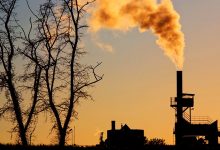Australia’s greenhouse gas emissions have fallen for the first time since 2015, but the reductions still lag behind what is needed to achieve the Morrison government’s 2030 emissions reduction targets.
According to analysis undertaken by consultancy NDEVR Environmental, Australia’s emissions fell by 0.9 per cent in the 2019 calendar year. This was underpinned by a 2.7 per cent drop in emissions for the last three months of 2019, which fell by an estimated 3.4 million tonnes compared to a year earlier.
The emissions reduction, however, was still well short of what is needed to meet the government’s 2030 Paris targets, as well as being short of what is needed as Australia’s fair share of reductions towards limiting global warming to below 2 degrees.
It raises new questions about the degree to which the Morrison government will be reliant on the “carry over” of surplus emission budgets from previous targets, a tactic that has been criticised for having no legal basis, and no environmental justification.
The fall was driven primarily by cuts in emissions in the electricity sector, which were at their lowest point since 2002. In the last three months of 2019, renewable energy penetration set a new record in Australia’s main grid, averaging 25.6 per cent over the quarter.
Growth in renewable energy generation was particularly strong in South Australia, with average penetration setting a new record of 59 per cent (an 8 per cent increase). New records were also set in New South Wales (19 per cent penetration), Queensland (15 per cent) and Victoria (23 per cent).
Conversely, the growth in renewables generation has pushed black coal generation out of the market, which recorded its lowest level since 2005.
The Australian Energy Market Operator made similar observations in its latest Quarterly Energy Dynamics report, noting that electricity emissions in the National Electricity Market had reached their lowest ever level.
The subdued demand for electricity has also pushed electricity prices lower, reaching their lowest level in four years.
However, parts of the Australian economy are continuing to head in different directions with respect to emissions, with the fall in electricity emissions partially offset by increases in other parts of the Australian economy, including the transport sector which continued its upward trend, reaching its highest level on record.
NDEVR estimated that if Australia’s emissions continued to fall at their current rate, the 2030 emission reduction target to cut emissions by 26% to 28% would not be met until 2095, 65 years behind schedule.
NDEVR expects the fall in emissions to continue into the first three months of 2020, and will be particularly impacted by Covid-19.
NDEVR said that while it was currently too soon to assess the full impact of the Covid-19 shutdown on Australia’s emissions, it had already observed a 5 per cent fall in electricity consumption in March 2020 compared to March 2019, and April was also tracking below 2019 levels.
The overall reduction in electricity demand has been less than some initially predicted, with Australian electricity consumption falling by a much smaller amount compared to countries like Italy and the United Kingdom, which saw demand fall by 15% to 25% as a result of the Covid-19 lockdown.
Sharp falls in fuel use, particularly from air and road transport, are also expected and likely to contribute to a noticeable drop in emissions in the first half of 2020.
Detailed data on the impact of an intense Australian summer dominated by bushfires on national emissions are beginning to emerge.
A report published by the Department of Industry, Science, Energy and Resources estimated that as must as 830 million tonnes of emissions were released as a result of the 2020 fire season, which represents more than a year and a half of Australia’s total annual emissions.
However, the department expects that most of these emissions will eventually be re-absorbed, as forests recover. The department estimated that the vast majority of bushfire emissions could be absorbed by returning forests within the next 10-15 years.
Scientists have warned that while the immediate reductions in emissions are welcome, the long-term impacts on emissions are most important, particularly if there is a sharp spike in emissions as countries exit lockdowns.
Researchers had already observed increases in air pollution and emissions levels in China, as the country begins to emerge from its own Covid-19 shutdown, and begins to ramp up production.
RenewEconomy and the Smart Energy Council will be co-hosting a “virtual conference” on May 6, focusing on a renewables-led economic recovery, featuring industry leaders, analysts and advocates. More information and registration here.
RenewEconomy and its sister sites One Step Off The Grid and The Driven will continue to publish throughout the Covid-19 crisis, posting good news about technology and project development, and holding government, regulators and business to account. But as the conference market evaporates, and some advertisers pull in their budgets, readers can help by making a voluntary donation here to help ensure we can continue to offer the service free of charge and to as wide an audience as possible. Thankyou for your support.










